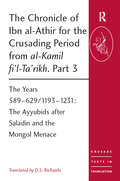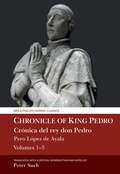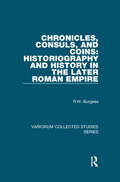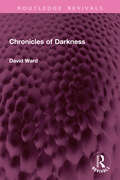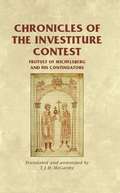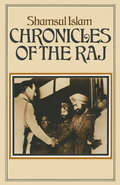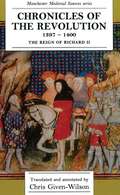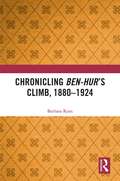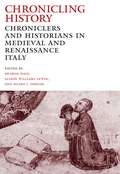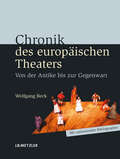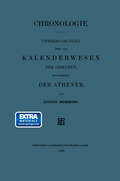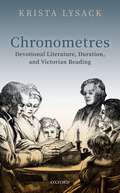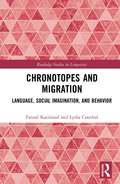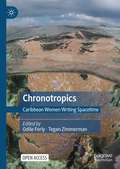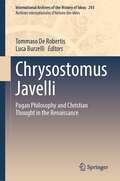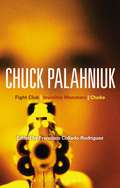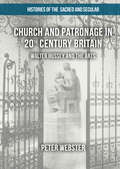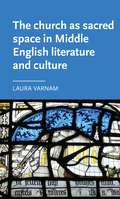- Table View
- List View
The Chronicle of Ibn al-Athir for the Crusading Period from al-Kamil fi'l-Ta'rikh. Part 3: The Years 589–629/1193–1231: The Ayyubids after Saladin and the Mongol Menace (Crusade Texts in Translation)
by D. S. RichardsThe Chronicle of Ibn al-Athir (1160-1233AD), entitled "al-Kamil fi'l-Ta'rikh", is one of the outstanding sources for the history of the mediaeval world. It covers the whole sweep of Islamic history almost up to the death of its author and, with the sources available to him, he attempted to embrace the widest geographical spread; events in Iraq, Iran and further East run in counterpoint with those involving North Africa and Spain. From the time of the arrival of the Crusaders in the Levant, their activities and the Muslim response become the focus of the work. A significant portion of this third part deals with the internal rivalries of the Ayyubid successors of Saladin, their changing relations with the Crusader states and in particular the events of the Damietta Crusade. As always, these events are portrayed against the wider background, with considerable emphasis on events in the eastern Islamic world, the fortunes of the Khwarazm Shahs and the first incursions of the Mongols.
The Chronicle of Ibn al-Athir for the Crusading Period from al-Kamil fi'l-Ta'rikh. Part 3: The Years 589–629/1193–1231: The Ayyubids after Saladin and the Mongol Menace (Crusade Texts in Translation)
by D. S. RichardsThe Chronicle of Ibn al-Athir (1160-1233AD), entitled "al-Kamil fi'l-Ta'rikh", is one of the outstanding sources for the history of the mediaeval world. It covers the whole sweep of Islamic history almost up to the death of its author and, with the sources available to him, he attempted to embrace the widest geographical spread; events in Iraq, Iran and further East run in counterpoint with those involving North Africa and Spain. From the time of the arrival of the Crusaders in the Levant, their activities and the Muslim response become the focus of the work. A significant portion of this third part deals with the internal rivalries of the Ayyubid successors of Saladin, their changing relations with the Crusader states and in particular the events of the Damietta Crusade. As always, these events are portrayed against the wider background, with considerable emphasis on events in the eastern Islamic world, the fortunes of the Khwarazm Shahs and the first incursions of the Mongols.
Chronicle of King Pedro Volumes 1 - 3: Pero López de Ayala (Aris & Phillips Hispanic Classics)
by Peter SuchPero López de Ayala’s Chronicle of King Pedro provides a compelling and richly informative account of the turbulent reign of the notorious but enigmatic fourteenth-century Castilian monarch who came to be known as Pedro el Cruel. It is a vitally important source for our understanding of the history of the Iberian Peninsula during this critical period in its development and of the complex social and political divisions by which the Spanish kingdoms were torn. This three-volume Chronicle gives us a gripping and wide-ranging picture of a period characterized by harsh brutality, conflict and betrayal but at the same time by the ideals of chivalry, memorably personified in figures such as the Black Prince and Bertrand du Guesclin. At its centre is the chilling portrait of King Pedro, a brilliantly constructed image of self-destructive evil. The translation is accompanied by a Spanish text taken from Germán Orduna’s groundbreaking edition and by detailed notes. The introduction explores the background to the Chronicle’s composition and sets López de Ayala’s account against a broad canvas of events in the Spanish kingdoms and beyond. It examines how the chronicler’s subtle artistry was used to create a picture of a deeply flawed monarch which has continued to exercise a profound fascination over the centuries.
Chronicles, Consuls, and Coins: Historiography and History in the Later Roman Empire
by R.W. BurgessThe papers collected in this volume focus on the sources for reconstructing the history of the third to fifth centuries AD. The first section, 'Historiography', looks at a small group of chronicles and breviaria whose texts are fundamental for our reconstruction of the history of the third and fourth centuries, some well known, others much less so: Eusebius of Caesarea, Jerome, the lost Kaisergeschichte, and Eutropius. In this section the goal in each case is a specific attempt to come to a better understanding of the structure, composition, date, or author of these historical texts. The second section, 'History', presents a group of historical studies, ranging in time from the death of Constantine in 337 to the vicennalia of Anastasius in 511. In these papers the keys to the conclusions offered arise from a better understanding of the literary sources - particularly chronicles and consularia -, an understanding of the evolution of historical accounts over time, or the employment of sources that are either new or unusual in these particular contexts: consular fasti, coins, papyri, and itineraries.
Chronicles, Consuls, and Coins: Historiography and History in the Later Roman Empire
by R.W. BurgessThe papers collected in this volume focus on the sources for reconstructing the history of the third to fifth centuries AD. The first section, 'Historiography', looks at a small group of chronicles and breviaria whose texts are fundamental for our reconstruction of the history of the third and fourth centuries, some well known, others much less so: Eusebius of Caesarea, Jerome, the lost Kaisergeschichte, and Eutropius. In this section the goal in each case is a specific attempt to come to a better understanding of the structure, composition, date, or author of these historical texts. The second section, 'History', presents a group of historical studies, ranging in time from the death of Constantine in 337 to the vicennalia of Anastasius in 511. In these papers the keys to the conclusions offered arise from a better understanding of the literary sources - particularly chronicles and consularia -, an understanding of the evolution of historical accounts over time, or the employment of sources that are either new or unusual in these particular contexts: consular fasti, coins, papyri, and itineraries.
Chronicles of Darkness (Routledge Revivals)
by David WardFirst published in 1989, Chronicles of Darkness is about images of Africa seen through the eyes of writers, visitors, residents, and native-born. They range from Joseph Conrad and Olive Schreiner, through Laurens van der Post, Karen Blixen and Evelyn Waugh, to more recent writers like Nadine Gordimer, Andre Brink and J.M. Coetzee.Such writers have frequently been faced with feelings of alienation, marginality, exile, self-consciousness, and egoism. It is only in this sense- that the eyes which see are shadowed and troubled- that Africa is a ‘dark continent’ and that these writings are ‘chronicles of darkness’. In some cases, Africa, even if merely a backdrop painted in crude and garish colors, becomes a way of revealing or admitting something about ‘Europe’ which might be concealed when a writer performs in a different theatre. This is an interesting read for scholars and researchers of English literature and African studies.
Chronicles of Darkness (Routledge Revivals)
by David WardFirst published in 1989, Chronicles of Darkness is about images of Africa seen through the eyes of writers, visitors, residents, and native-born. They range from Joseph Conrad and Olive Schreiner, through Laurens van der Post, Karen Blixen and Evelyn Waugh, to more recent writers like Nadine Gordimer, Andre Brink and J.M. Coetzee.Such writers have frequently been faced with feelings of alienation, marginality, exile, self-consciousness, and egoism. It is only in this sense- that the eyes which see are shadowed and troubled- that Africa is a ‘dark continent’ and that these writings are ‘chronicles of darkness’. In some cases, Africa, even if merely a backdrop painted in crude and garish colors, becomes a way of revealing or admitting something about ‘Europe’ which might be concealed when a writer performs in a different theatre. This is an interesting read for scholars and researchers of English literature and African studies.
Chronicles of the Investiture Contest: Frutolf of Michelsberg and his continuators (Manchester Medieval Sources)
by Rosemary Horrox Simon Maclean T. J. McCarthyThis book is the first English translation of one of the most significant chronicles of the Middle Ages. Written in Bamberg at the end of the eleventh century, Frutolf of Michelsberg’s Chronicle offers a lively and vivid account of the great struggle between the German emperors and the papacy known today as the Investiture Contest. Together with numerous continuations written in the first quarter of the twelfth century, Frutolf’s Chronicle offers an engaging and accessible snapshot of how medieval people reacted to a conflict that led to civil war in Germany and Italy, and fundamentally altered the relationship of church and state in Western society.
Chronicles of the Raj: A Study of Literary Reaction to the Imperial Idea towards the End of the Raj (pdf)
by Shamsul IslamChronicles of the Revolution, 1397–1400: The reign of Richard II (Manchester Medieval Sources)
by Chris Given-WilsonThis collection of sources covers one of the most controversial and shocking episodes in medieval English history, the 'tyranny' and deposition of Richard II and the usurpation of the throne by his cousin, Henry Bolingbroke, who became King Henry IV. Contemporaries were sharply divided about the rights and wrongs of both Richard and Henry, and this division is reflected in the texts which form the major part of these sources. All the principal contemporary chronicles are represented in this collection, from the violently partisan Thomas Walsingham, chronicler of St Alban's Abbey who saw Richard as a tyrant and murderer, to the indignant Dieulacres chronicler, who claimed that the 'innocent king' was tricked into surrender by his perjured barons.
Chronicling Ben-Hur’s Climb, 1880-1924
by Barbara RyanFirst published in 1880, Lew Wallace’s Ben-Hur is one of the best-selling novels of all time. Employing analytical strategies from the fields of literature, fan studies, reception history, and media research, Barbara Ryan traces Ben-Hur’s popularity from 1880 to 1924. She analyzes fan mail as well as a wide range of manuscript and print sources, using as her starting place two letters in which admirers declared that they would rather be the author of Ben-Hur than to be President of the United States. Ryan’s discussion of the novel in terms of its contemporary fandom makes it possible for her to dispel misconceptions about the novel’s audience which include assumptions about its popularity with all Christians. She makes fascinating connections between Ben-Hur, slavery discourse, and the changing nature of U.S. politics to challenge critics who assume that Wallace consciously used a sure-fire formula. By shedding light on attempts to squash the novel’s popularity, Ryan examines dramatizations of Ben-Hur by amateurs and on Broadway. Her in-depth reception history of Ben-Hur’s incarnations in print and on stage establishes the novel’s importance for understanding nineteenth-century U.S. literature, politics, and culture.
Chronicling Ben-Hur’s Climb, 1880-1924
by Barbara RyanFirst published in 1880, Lew Wallace’s Ben-Hur is one of the best-selling novels of all time. Employing analytical strategies from the fields of literature, fan studies, reception history, and media research, Barbara Ryan traces Ben-Hur’s popularity from 1880 to 1924. She analyzes fan mail as well as a wide range of manuscript and print sources, using as her starting place two letters in which admirers declared that they would rather be the author of Ben-Hur than to be President of the United States. Ryan’s discussion of the novel in terms of its contemporary fandom makes it possible for her to dispel misconceptions about the novel’s audience which include assumptions about its popularity with all Christians. She makes fascinating connections between Ben-Hur, slavery discourse, and the changing nature of U.S. politics to challenge critics who assume that Wallace consciously used a sure-fire formula. By shedding light on attempts to squash the novel’s popularity, Ryan examines dramatizations of Ben-Hur by amateurs and on Broadway. Her in-depth reception history of Ben-Hur’s incarnations in print and on stage establishes the novel’s importance for understanding nineteenth-century U.S. literature, politics, and culture.
Chronicling History: Chroniclers And Historians In Medieval And Renaissance Italy
by Sharon Dale Alison Williams Lewin Duane J. OsheimThis book examines historical writing from the late Middle Ages and Renaissance in Italy. Thousands of annals, chronicles, and histories were produced reflecting a complex society that evolved from the creation of the Lombard kingdom through the forging of a political order based on communes and finally into a system of regional Renaissance states. It is meant to serve as an introduction to this largely unappreciated historical resource.
Chronik des europäischen Theaters: Von der Antike bis zur Gegenwart
by Wolfgang BeckZweieinhalb Jahrtausende Theater in Europa. Die Chronik zeigt Schauspielkunst unter den verschiedensten politischen, historischen und ästhetischen Vorzeichen und enthält die wichtigsten Personen und Bühnenereignisse, kulturhistorische und politische Hintergründe sowie Daten zum Theaterwesen. Ein ideales Informationsmittel für alle, die praktisch und theoretisch, schreibend oder spielend mit Theater zu tun haben.
Chronologie: Untersuchungen über das Kalenderwesen der Griechen, Insonderheit der Athener
by August MommsenChronometres: Devotional Literature, Duration, and Victorian Reading
by Krista LysackWhat does it mean to feel time, to sense its passing along the sinews and nerves of the body as much as the synapses of the mind? And how do books, as material arrangements of print and paper, mediate such temporal experiences? Chronometres: Devotional Literature, Duration, and Victorian Reading Culture is a study of the time-inflected reading practices of religious literature, the single largest market for print in Victorian Britain. It examines poetic cycles by John Keble, Alfred Tennyson, Christina Rossetti, and Frances Ridley Havergal; family prayer manuals, Sunday-reading books and periodicals; and devotional gift books and daily textbooks. Designed for diurnal and weekly reading, chronometrical literature tuned its readers' attentions to the idea of eternity and the everlasting peace of spiritual transcendence, but only in so far as it parcelled out reading into discrete increments that resembled the new industrial time-scales of factories and railway schedules. Chronometres thus takes up print culture, affect theory, and the religious turn in literary studies in order to explore the intersections between devotional practice and the condition of modernity. It argues that what defines Victorian devotional literature is the experience of its time signatures, those structures of feeling associated with its reading durations. For many Victorians, reading devotionally increasingly meant reading in regular portions and often according to the calendar and work-day in contrast to the liturgical year. Keeping pace with the temporal measures of modernity, devotion became a routinized practice: a way of synchronizing the interior life of spirit with the exigencies of clock time. Chronometres considers how the deliverances afforded through time-scaled reading are persistently materialised in the body, both that of the book and of the reader. Recognizing that literature and devotion are not timeless abstractions, it asks how the materiality of books, conceived as horological relationships through reading, might bring about the felt experience of time. Even as Victorian devotion invites us to tarry over the page, it also prompts the question: what if it is 'eternity' that keeps time with the clock?
Chronometres: Devotional Literature, Duration, and Victorian Reading
by Krista LysackWhat does it mean to feel time, to sense its passing along the sinews and nerves of the body as much as the synapses of the mind? And how do books, as material arrangements of print and paper, mediate such temporal experiences? Chronometres: Devotional Literature, Duration, and Victorian Reading Culture is a study of the time-inflected reading practices of religious literature, the single largest market for print in Victorian Britain. It examines poetic cycles by John Keble, Alfred Tennyson, Christina Rossetti, and Frances Ridley Havergal; family prayer manuals, Sunday-reading books and periodicals; and devotional gift books and daily textbooks. Designed for diurnal and weekly reading, chronometrical literature tuned its readers' attentions to the idea of eternity and the everlasting peace of spiritual transcendence, but only in so far as it parcelled out reading into discrete increments that resembled the new industrial time-scales of factories and railway schedules. Chronometres thus takes up print culture, affect theory, and the religious turn in literary studies in order to explore the intersections between devotional practice and the condition of modernity. It argues that what defines Victorian devotional literature is the experience of its time signatures, those structures of feeling associated with its reading durations. For many Victorians, reading devotionally increasingly meant reading in regular portions and often according to the calendar and work-day in contrast to the liturgical year. Keeping pace with the temporal measures of modernity, devotion became a routinized practice: a way of synchronizing the interior life of spirit with the exigencies of clock time. Chronometres considers how the deliverances afforded through time-scaled reading are persistently materialised in the body, both that of the book and of the reader. Recognizing that literature and devotion are not timeless abstractions, it asks how the materiality of books, conceived as horological relationships through reading, might bring about the felt experience of time. Even as Victorian devotion invites us to tarry over the page, it also prompts the question: what if it is 'eternity' that keeps time with the clock?
Chronotopes and Migration: Language, Social Imagination, and Behavior (Routledge Studies in Linguistics)
by Farzad Karimzad Lydia CatedralIn Chronotopes and Migration: Language, Social Imagination, and Behavior, Farzad Karimzad and Lydia Catedral investigate migrants’ polycentric identities, imaginations, ideologies, and orientations to home and host countries through the notion of chronotope. The book focuses on the authors’ ethnographically situated research with two migrant populations – Iranians and Uzbeks in the United States – to highlight the institutional constraints and individual subjectivities involved in transnational mobility. The authors provide a model for how the notion of cultural chronotope can be applied to the study of language and migration at multiple scale levels, and they showcase a coherent picture of the ways in which chronotopes organize various aspects of migrant life. This book is a critical contribution to the conversation surrounding the sociocultural-linguistic uses of the chronotope, demonstrating its applicability not only to theorizing migration but also to theorizing language and social life more broadly.
Chronotopes and Migration: Language, Social Imagination, and Behavior (Routledge Studies in Linguistics)
by Farzad Karimzad Lydia CatedralIn Chronotopes and Migration: Language, Social Imagination, and Behavior, Farzad Karimzad and Lydia Catedral investigate migrants’ polycentric identities, imaginations, ideologies, and orientations to home and host countries through the notion of chronotope. The book focuses on the authors’ ethnographically situated research with two migrant populations – Iranians and Uzbeks in the United States – to highlight the institutional constraints and individual subjectivities involved in transnational mobility. The authors provide a model for how the notion of cultural chronotope can be applied to the study of language and migration at multiple scale levels, and they showcase a coherent picture of the ways in which chronotopes organize various aspects of migrant life. This book is a critical contribution to the conversation surrounding the sociocultural-linguistic uses of the chronotope, demonstrating its applicability not only to theorizing migration but also to theorizing language and social life more broadly.
Chronotropics: Caribbean Women Writing Spacetime
by Odile Ferly Tegan ZimmermanThis book deconstructs androcentric approaches to spacetime inherited from western modernity through its theoretical frame of the chronotropics. It sheds light on the literary acts of archival disruption, radical remapping, and epistemic marronnage by twenty-first-century Caribbean women writers to restore a connection to spacetime, expanding it within and beyond the region. Arguing that the chronotropics points to a vocation for social justice and collective healing, this pan-Caribbean volume returns to autochthonous ontologies and epistemologies to propose a poetics and politics of the chronotropics that is anticolonial, gender inclusive, pluralistic, and non-anthropocentric. This is an open access book.
Chrysostomus Javelli: Pagan Philosophy and Christian Thought in the Renaissance (International Archives of the History of Ideas Archives internationales d'histoire des idées #243)
by Tommaso De Robertis Luca BurzelliThe volume provides the first book-length study of Chrysostomus Javelli’s philosophical works. An Italian university professor and a prominent figure in the intellectual landscape of sixteenth-century Europe, Javelli (ca. 1470-1540) was the author of insightful commentaries on both Plato and Aristotle as well as of original works in which he laid the foundations of a new Christian philosophy. In this volume, a group of leading scholars from around the world guide readers through the many facets of Javelli’s philosophical corpus, showing the long-term impact of his ideas on Western philosophical thought. The twelve essays of this volume shed light on an understudied yet central figure of Renaissance culture, revealing new connections and unexplored influences. This book is a valuable tool for students and scholars of early modern philosophy, classical tradition, and Christian theology, contributing to the understanding of a neglected chapter of Western intellectual history.
Chuck Palahniuk: Fight Club, Invisible Monsters, Choke (Bloomsbury Studies in Contemporary North American Fiction)
by Francisco Collado-RodriguezOffering a world full of traumatized characters trapped in a consumerist society where men, women, sex and gender have become unstable commodities, Chuck Palahniuk has become one of the most controversial of contemporary novelists. This book is the first guide to bring together scholars from a full range of critical perspectives to explore three of Palahniuk's most widely-studied novels: Fight Club, Invisible Monsters and Choke. Examining these works in light of such key critical themes as violence, masculinity, postmodern aesthetics and trauma, the book also explores the ethical dimension of Palahniuk's work that is often lost in the heat of the controversies surrounding his books. Together with annotated guides to further reading, Chuck Palahniuk also includes section introductions surveying the contexts and reception of each novel, making this an essential guide for students and scholars of contemporary literature.
Chuck Palahniuk: Fight Club, Invisible Monsters, Choke (Bloomsbury Studies in Contemporary North American Fiction)
by Francisco Collado-RodriguezOffering a world full of traumatized characters trapped in a consumerist society where men, women, sex and gender have become unstable commodities, Chuck Palahniuk has become one of the most controversial of contemporary novelists. This book is the first guide to bring together scholars from a full range of critical perspectives to explore three of Palahniuk's most widely-studied novels: Fight Club, Invisible Monsters and Choke. Examining these works in light of such key critical themes as violence, masculinity, postmodern aesthetics and trauma, the book also explores the ethical dimension of Palahniuk's work that is often lost in the heat of the controversies surrounding his books. Together with annotated guides to further reading, Chuck Palahniuk also includes section introductions surveying the contexts and reception of each novel, making this an essential guide for students and scholars of contemporary literature.
Church and Patronage in 20th Century Britain: Walter Hussey and the Arts (Histories of the Sacred and Secular, 1700–2000)
by Peter WebsterThis book is the first full-length treatment of Walter Hussey's work as a patron between 1943 and 1978, first for the Anglican parish church of St Matthew in Northampton, and then at Chichester Cathedral. He was responsible for the most significant sequence of works of art commissioned for the British churches in the twentieth century. They included music by Benjamin Britten, Leonard Bernstein and William Walton, visual art by Henry Moore, Graham Sutherland and Marc Chagall, and poetry by W. H. Auden. Placing Hussey in theological context and in a period of rapid cultural change, it explores the making and reception of the commissions, and the longer-term influence of his work, still felt today. As well as contributing to the religious and cultural history of Britain, and of Anglo-Catholicism and the cathedrals in particular, the book will be of interest to all those concerned with the relationship between theology and the arts, and to historians of music and the visual arts.
The church as sacred space in Middle English literature and culture (Manchester Medieval Literature And Culture Ser.)
by Laura VarnamThis book places us at the heart of medieval religious life, standing inside the church with the medieval laity in order to ask what it meant to them and why. Drawing on a wide range of theoretical and interdisciplinary approaches, it examines the interplay of vernacular literature, ritual and material culture at the centre of parish life.
